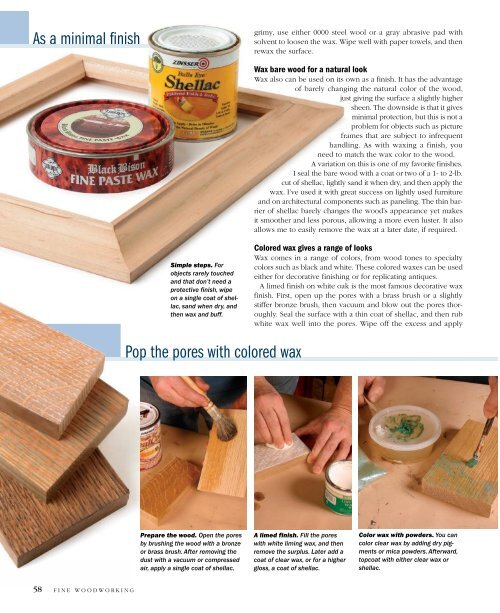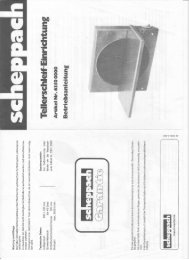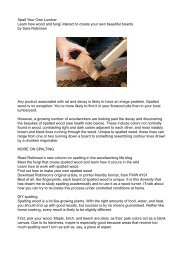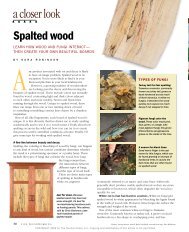Wax Primer
Wax Primer
Wax Primer
Create successful ePaper yourself
Turn your PDF publications into a flip-book with our unique Google optimized e-Paper software.
As a minimal finish<br />
grimy, use either 0000 steel wool or a gray abrasive pad with<br />
solvent to loosen the wax. Wipe well with paper towels, and then<br />
rewax the surface.<br />
<strong>Wax</strong> bare wood for a natural look<br />
<strong>Wax</strong> also can be used on its own as a finish. It has the advantage<br />
of barely changing the natural color of the wood,<br />
just giving the surface a slightly higher<br />
sheen. The downside is that it gives<br />
minimal protection, but this is not a<br />
problem for objects such as picture<br />
frames that are subject to infrequent<br />
handling. As with waxing a finish, you<br />
need to match the wax color to the wood.<br />
A variation on this is one of my favorite finishes.<br />
I seal the bare wood with a coat or two of a 1- to 2-lb.<br />
cut of shellac, lightly sand it when dry, and then apply the<br />
wax. I’ve used it with great success on lightly used furniture<br />
and on architectural components such as paneling. The thin barrier<br />
of shellac barely changes the wood’s appearance yet makes<br />
it smoother and less porous, allowing a more even luster. It also<br />
allows me to easily remove the wax at a later date, if required.<br />
Simple steps. For<br />
objects rarely touched<br />
and that don’t need a<br />
protective finish, wipe<br />
on a single coat of shellac,<br />
sand when dry, and<br />
then wax and buff.<br />
Colored wax gives a range of looks<br />
<strong>Wax</strong> comes in a range of colors, from wood tones to specialty<br />
colors such as black and white. These colored waxes can be used<br />
either for decorative finishing or for replicating antiques.<br />
A limed finish on white oak is the most famous decorative wax<br />
finish. First, open up the pores with a brass brush or a slightly<br />
stiffer bronze brush, then vacuum and blow out the pores thoroughly.<br />
Seal the surface with a thin coat of shellac, and then rub<br />
white wax well into the pores. Wipe off the excess and apply<br />
Pop the pores with colored wax<br />
Prepare the wood. Open the pores<br />
by brushing the wood with a bronze<br />
or brass brush. After removing the<br />
dust with a vacuum or compressed<br />
air, apply a single coat of shellac.<br />
A limed finish. Fill the pores<br />
with white liming wax, and then<br />
remove the surplus. Later add a<br />
coat of clear wax, or for a higher<br />
gloss, a coat of shellac.<br />
Color wax with powders. You can<br />
color clear wax by adding dry pigments<br />
or mica powders. Afterward,<br />
topcoat with either clear wax or<br />
shellac.<br />
58<br />
F I N E W O O D W O R K I N G
















